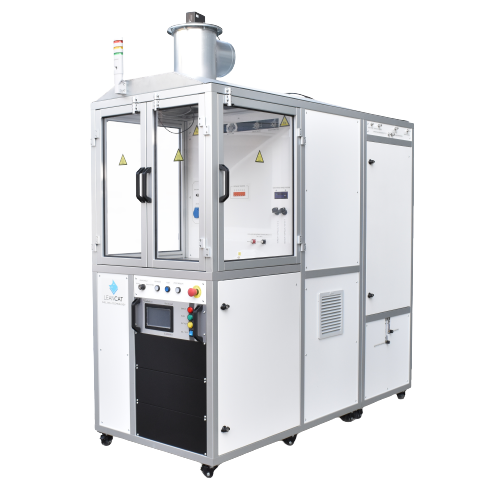- What is the main function of fuel cell testing equipment?
- What are the different types of fuel cell test equipment?
- What are the key performance criteria of state-of-the-art fuel cell testing equipment?
- Which are the main use cases for such testing equipment for hydrogen fuel cell systems?
- What are the components of the fuel cell testing equipment and their function?
- Quality assurance
- What are the most important protocols for fuel cell testing?
- What is the main difference between testing a fuel cell and testing a fuel cell stack? What do such tests have in common?
- How long is a fuel cell typically tested? Is there a market standard?
Browse fuel cell testing equipment’s from leading suppliers on our marketplace!
What is the main function of fuel cell testing equipment?
A fuel cell is a complex device composed of many components with different functions, material properties and characteristics. As such, it takes more than just a few parameters to classify a fuel cell according to its main characteristics and operational limits. Fuel cell testing equipment enables the characterization of fuel cells, either during the development phase, so as to facilitate the optimization of a design and the materials used, or during production in order to benchmark and compare individual produced units. The fuel cell test equipment’s deployed from a central assembly, known as the fuel cell test station, also called a test rig, test bed, or test bench.
What are the different types of fuel cell test equipment?
Depending on the level at which the testing equipment operates, we can distinguish two different types:
a) Cell testing equipment, or stack testing equipment
This testing equipment essentially substitutes the role of Balance-of-Plant components in a hydrogen fuel cell module, thereby creating well-defined and well-controlled conditions for a single cell or an entire stack.

Example – SOFC test station convenient testing of single cells and short stacks
b) Fuel cell system (module) testing equipment
The equipment for testing an entire fuel cell module is more related to the control systems and control strategies used in a fuel cell module. It typically features various sensors to monitor the state of the system. This article describes only the first category, i.e., single-cell and stack testing equipment.
Apart from this, fuel cell test equipment also differs based on the specific hydrogen fuel cell technology. A pem fuel cell test station must encompass a variety of devices, as needed for cells and stacks, based on whether low-temperature PEM or high-temperature PEM is used. In contrast, solid-oxide hydrogen fuell cell technology requires a markedly different set of implements for testing as compared to those used for pem fuel cell testing.
What are the key performance criteria of state-of-the-art fuel cell testing equipment?
The exact performance criteria for fuel cell testing equipment differ based on the specific use case and the actual fuel cell testing procedure. There are different requirements for the testing of small single cells and large automotive-grade stacks. However, the following features can be regarded as industry standard for cell and stack testing:
- Fully integrated and automated fuel cell test station for unattended operation
- Integrated safety system with alarm management
- Wetted materials made from Stainless Steel (316L) or Teflon
These are the criteria that can be used to compare test stations from different manufacturers:
- Accuracy of the control systems for individual parts of the technology (see below).
- Dynamics of setpoint change, important e.g., for dewpoint control and the rate of change of dew-point temperature.
- The degree to which the equipment can be customized.
- How user-friendly and customizable the user interface for the software is.
Which are the main use cases for such testing equipment for hydrogen fuel cell systems?
In general, fuel cell testing equipment is used in both R&D and production, specifically EoL, or end-of-line testing. Small single-cell test stations are used for the development of materials in the Membrane Electrode Assembly (catalysts, ionomers, binders, etc.). Stack test stations can be used to validate a specific stack design during stack development (bipolar-plate design, flow-channel geometry, etc.), for testing the limits of operation (drive cycle tests) or long-term durability, or to benchmark each individual manufactured stack during production.
What are the components of the fuel cell testing equipment and their function?
A typical fuel cell test station is composed of:
a) Gas conditioning lines (anode and cathode)
- Gas inlet: Interfaces the test station with laboratory gas distribution lines
- Mass Flow Controller(s): Controls the flow rate of the gas stream
- Humidification system: Controls the humidity of the gas stream
- Gas heating system: Controls the temperature of the gas stream
- Backpressure regulator: Controls the pressure at which the cell/stack operates
- Water separator: Removes liquid water from the outlet stream
b) Liquid cooling system (if applicable)
- Controls the temperature of a cell/stack and interfaces the primary cooling circuit using the lab cooling water via a heat exchanger
c) Electronic load or potentiostat with EIS
- Connects electrically to cell/stack terminals and provides characterization techniques
Quality assurance
Test equipment itself must of course be benchmarked, standardised, and calibrated so as to provide reliable and consistent results. This includes testing conducted prior to commissioning of the fuel cell testing equipment. The functionality of each specific part of the technology and its controllers are tested before being placed into operation.
Regular inspections during use are also necessary. Specifically, the testing equipment needs to be periodically inspected for tightness of the pressurized gas lines.
What are the most important protocols for fuel cell testing?
Protocols for testing of fuel cells differ based on the type of fuel cell and application of the technology. Generally, there are several protocols that can be followed:
- EU Harmonized Test Protocol for PEM MEA
- DOE Cell Component Accelerated Stress Test
What is the main difference between testing a fuel cell and testing a fuel cell stack? What do such tests have in common?
In a fuel cell test stand, gas conditioning lines and a cooling circuit are dimensioned based on the maximum power of the tested device, as this determines the consumption of gases and heat production. For this part of the test station it is not very relevant whether the Device Under Test (DUT) is a large-area single cell, or a stack with smaller cell area. The main criteria is whether these have comparable max. power output. However, the electronic load or potentiostat must be always selected for a specific configuration, as its maximum current and voltage determine the type of DUT that can be tested.
How long is a fuel cell typically tested? Is there a market standard?
The duration of a test can range from several minutes to measurement of a current-voltage characteristic over several months. The latter case would represent durability testing. As a result, the time requirements of testing are highly dependent on the specific use case.
Content contributed by Leancat
Leancat s.r.o. develops and manufactures professional fuel-cell testing equipment. Building on extensive knowledge from the development and application of fuel cell technology, we can offer customers from both academia and industry a wide portfolio of fuel cell test stations for PEM fuel cells and SOFC. Standard configurations cover power ranges from 100 W to 20 kW and we offer a variety of customization options based on the requests of our customers.
Last update: 15.1.2023




